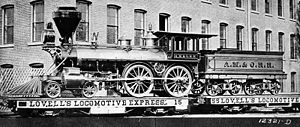This article includes a list of references, related reading, or external links, but its sources remain unclear because it lacks inline citations. (January 2013) |
 Locomotive type 4-4-0 American company Atlantic, Mississippi and Ohio Railroad. | |
| Overview | |
|---|---|
| Headquarters | Norfolk, Virginia |
| Locale | State of Virginia |
| Founder | William Mahone |
| Dates of operation | 1870–1882 |
| Successor | Norfolk and Western Railway |
| Technical | |
| Track gauge | 4 ft 8+1⁄2 in (1,435 mm) standard gauge |

Atlantic, Mississippi and Ohio Railroad (AM&O) was formed in 1870 in Virginia from three east–west railroads which traversed across the southern portion of the state. Organized and led by former Confederate general William Mahone (1826-1895), the 428-mile (689 km) line linked Norfolk with Bristol, Virginia by way of Suffolk, Petersburg, Lynchburg, and Salem. The AM&O was promoted as a trade link to the west, and further expansion was envisioned with the goal of increasing Virginia's Ohio Valley and Mississippi Valley commerce. It was heavily backed by investors from England and Scotland.
The AM&O went into receivership after the U.S. Financial Panic of 1873. After several years of continuing financial problems, Mahone's relationship with the bondholders soured, and he was removed as trustee, but was permitted to continue to lead operations. Finally, in 1881, the AM&O was sold at auction. It was acquired by other U.S. interests based in Philadelphia who outbid Mahone. They were already building Shenandoah Valley Railroad and had a new commodity in mind: bituminous coal. The AM&O was renamed to Norfolk and Western Railway (N&W). Norfolk & Western Railway was expanded west into the coalfields, and later into a much large system, eventually tapping the Ohio Valley and Mississippi Valley commerce as earlier promised Virginia. The N&W was combined with the Southern Railway, another profitable carrier, to form Norfolk Southern Corporation (NS) in 1982.
Today, much of the former Atlantic, Mississippi and Ohio Railroad remains in service for Norfolk Southern. The Fortune 500 company, headquartered in Norfolk, transports bituminous coal, intermodal shipping containers, automobile parts and completed vehicles, and other commodities in the 21st century global transportation markets. Most of the former AM&O lines are still part of the NS rail network.